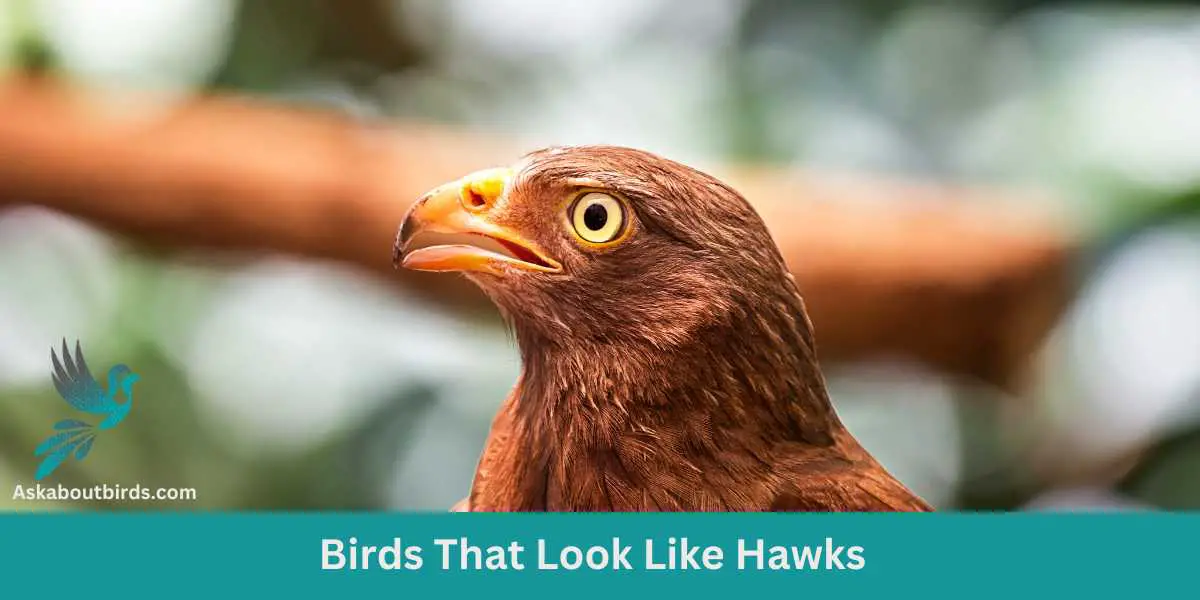Enthralling yet elusive, hawks stand as a symbol of power, agility, and grace in the avian kingdom. However, their characteristic appearance often overlaps with other predatory bird species, leading to confusion among bird enthusiasts and beginners alike.
We delve into the fascinating world of raptors and highlight 11 remarkable birds that resemble our majestic hawks.
Red-Tailed Hawk

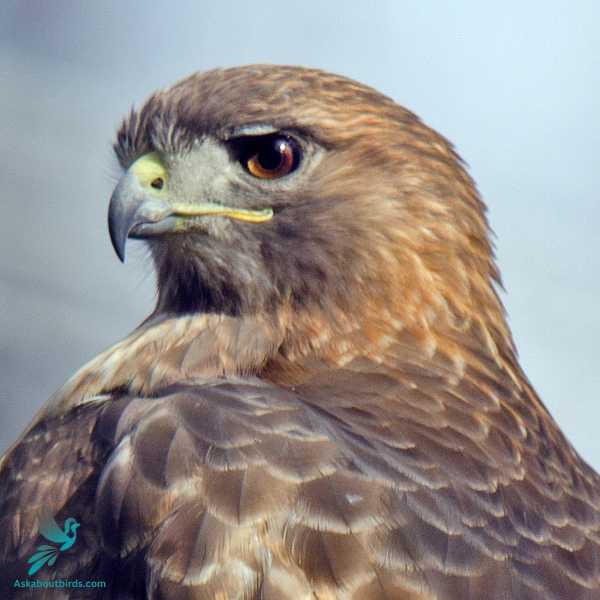
| Feature | Measurement |
|---|---|
| Scientific Name | Buteo jamaicensis |
| Length | 45–65 cm (18–26 in) |
| Wingspan | 110–141 cm (3 ft 7 in – 4 ft 8 in) |
| Weight | 690 to 1,600 g (1.5 to 3.5 lb) |
The Red-Tailed Hawk is a bird of prey that is commonly found across North America. This adaptable raptor is known for its brick-red tail, which is most noticeable in adults from above or underneath. The diet of the Red-Tailed Hawk is very diverse, including small mammals like mice and squirrels, as well as birds and reptiles.
This hawk is often seen perched on poles or soaring in wide circles high above fields, forests, and highways. Its habitat is extremely varied, ranging from desert and scrublands to forests and tropical rainforests. Its call, a raspy, screaming kee-eeeee-arr, is often used in movies to represent any bird of prey.
11 Birds That Look Like Hawks
Bald Eagle


| Feature | Measurement |
|---|---|
| Scientific Name | Haliaeetus leucocephalus |
| Length | 70–102 cm (28–40 in) |
| Wingspan | 1.8 and 2.3 m (5 ft 11 in and 7 ft 7 in) |
| Weight | 3 and 6.3 kg (6.6 and 13.9 lb) |
The Bald Eagle is a bird of prey native to North America, most recognizable for its striking features: a white head and tail contrasted by a dark brown body. This raptor primarily feeds on fish, which it catches with its strong, sharp talons. Bald Eagles are renowned for their impressive flight skills and can reach high speeds in the air.
Their nests, or eyries, are some of the largest of any bird species, often built near bodies of water in tall trees or cliffs for an optimal view of their surroundings. Bald Eagles have a significant cultural status in the United States, serving as the national bird and a symbol of freedom.
Similarities
- Like hawks, Bald Eagles are raptors, with strong, hooked beaks and sharp talons.
- They have a similar body size to large hawks.
- They also soar in flight, similar to many hawks.
Differences
- Bald Eagles are typically larger than most hawks.
- Bald Eagles have a white head and tail, unlike hawks.
- They primarily eat fish, while hawks tend to have a more varied diet.
Golden Eagle


| Feature | Measurement |
|---|---|
| Scientific Name | Aquila chrysaetos |
| Length | 66 to 102 centimetres (26 to 40 in) |
| Wingspan | 1.8 to 2.34 metres (5 ft 11 in to 7 ft 8 in) |
| Weight | 4.05 and 6.35 kg (8.9 and 14.0 lb) |
The Golden Eagle is a powerful raptor found across the Northern Hemisphere, known for its impressive agility and speed in flight. Its name comes from the beautiful golden feathers that adorn the back of its head and neck. These birds of prey are versatile hunters, feeding on a wide range of animals including rabbits, squirrels, and even larger prey like foxes and young deer.
Preferred habitats are typically in mountainous regions, but they can also be found in a variety of environments including deserts and plains. Golden Eagles are solitary creatures, often found alone or in pairs, and they build their nests, or eyries, high on cliff faces or in tall trees.
Similarities
- Golden Eagles, like hawks, are powerful predators.
- Both have strong talons and beaks used for hunting.
Differences
- Golden Eagles are larger and more powerful than most hawks.
- They have a golden sheen on their heads and necks, which is not seen in hawks.
Northern Harrier

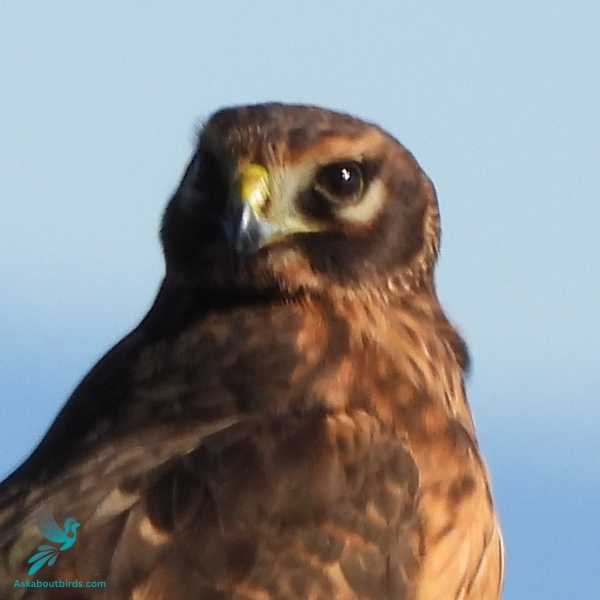
| Feature | Measurement |
|---|---|
| Scientific Name | Circus hudsonius |
| Length | 41–52 cm (16–20 in) |
| Wingspan | 97–122 cm (38–48 in) |
| Weight | Male 10 to 26 ounces (280 to 730 g) Female: 11 to 30 ounces (310 to 850 g) |
The Northern Harrier is a bird of prey that belongs to the Circinae subfamily and stands out due to its distinctively owl-like facial disk, slender body, and long tail. This species exhibits a low and slow flying pattern when hunting, often skimming just above the ground of open fields and marshes. The males are predominantly gray, while the females and young are brown with streaks of white.
Northern Harriers primarily feed on small mammals and birds. Unique among hawks, these birds possess an owl-like trait of using auditory cues as well as visual ones to locate and catch prey. They’re also known for their polygynous breeding system, where a male may have up to five mates at once, each nesting in different locations within his territory.
Similarities
- Northern Harriers share the same hooked beak and sharp talons as hawks.
- Both are skilled hunters.
Differences
- Unlike hawks, Northern Harriers fly low to the ground when hunting.
- They have a distinct white rump patch which most hawks lack.
Northern Goshawk

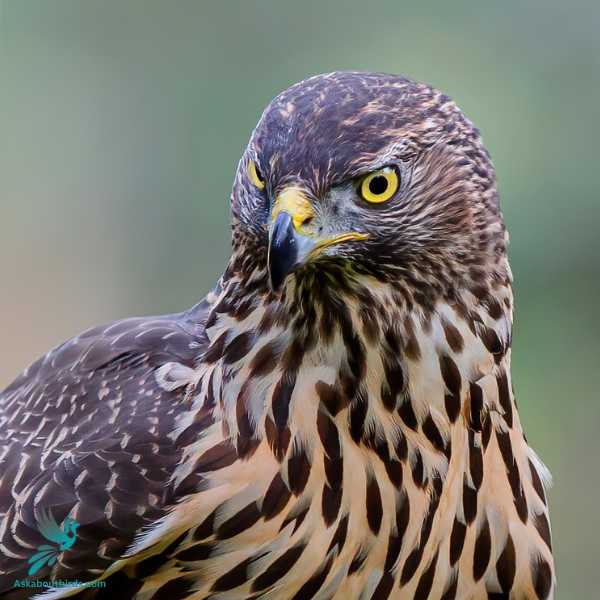
| Feature | Measurement |
|---|---|
| Scientific Name | Accipiter gentilis |
| Length | Male: 46 to 61 cm (18 to 24 in) / Female: 58 to 69 cm (23 to 27 in) |
| Wingspan | 89 to 105 cm (35 to 41 in)/ Female: 108 to 127 cm (43 to 50 in) |
| Weight |
The Northern Goshawk is a large bird of prey and the largest member of the Accipiter genus. Native to the Northern Hemisphere, it’s characterized by its slate-gray upperparts, finely barred underparts, and prominent white eyebrow stripe. The name “goshawk” originates from the Old English term for “goose hawk,” denoting the bird’s prowess at hunting large prey.
Northern Goshawks inhabit large, uninterrupted forests, where they are skilled hunters of a wide range of prey, including small mammals and medium to large birds. They are particularly agile fliers, often chasing prey through densely forested environments. These hawks are monogamous, with pairs often returning to the same nesting territory year after year. Their nests are built high in trees, and their breeding season is heralded by spectacular aerial displays and a loud, repetitive ‘kak-kak-kak’ call.
Similarities
- Like hawks, Northern Goshawks are raptors with sharp talons and beaks.
- They have a similar size and shape to many hawks.
Differences
- Goshawks have bolder, more striped plumage than most hawks.
- They are forest-dwellers, unlike many hawks which live in open habitats.
Common Buzzard
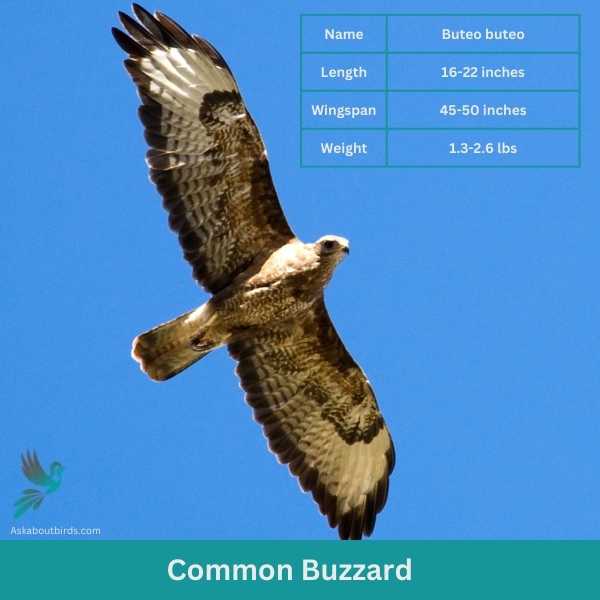
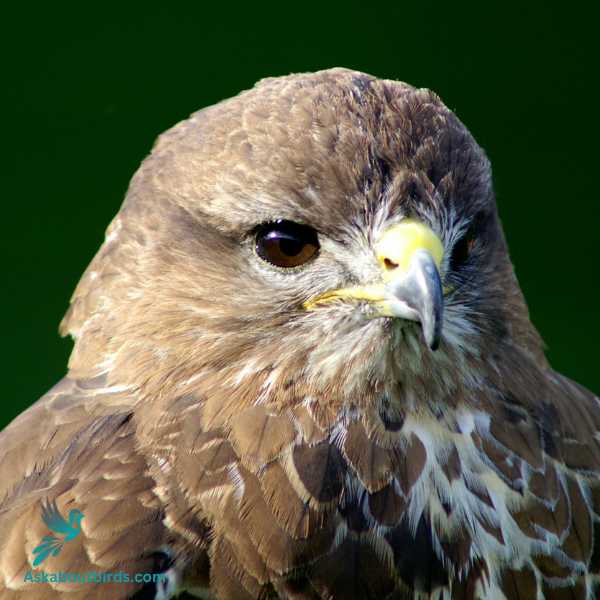
| Feature | Measurement |
|---|---|
| Scientific Name | Buteo buteo |
| Length | 16-22 inches |
| Wingspan | 45-50 inches |
| Weight | 1.3-2.6 lbs |
The Common Buzzard is a widely seen bird of prey across Europe and parts of Asia, known for its robust build and broad, rounded wings.
Appearance: Common Buzzards display variation in their plumage, ranging from very dark brown to much lighter shades. They typically feature a spread tail and broad, rounded wings in flight. When perched, their sturdy build and keen eyes are noticeable, contributing to their formidable reputation as predators.
Diet: The Common Buzzard’s diet primarily consists of small mammals, birds, and carrion. Their hunting style is often a patient one, as they perch in trees or on posts, waiting for the opportune moment to strike their prey.
Reproduction: The nesting sites of Common Buzzards are usually trees where they build large nests. The female typically lays between 2 to 4 eggs.
Similarities
- Common Buzzards, like hawks, are raptors, skilled at soaring and hunting.
- They are similar in size to many hawks.
Differences
- They have broader, rounder wings compared to hawks.
- Common Buzzards often have more varied plumage, ranging from very light to very dark.
American Kestrel
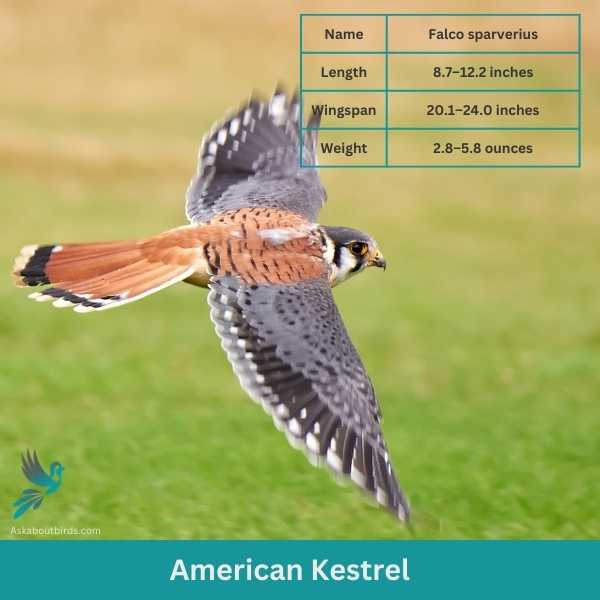

| Feature | Measurement |
|---|---|
| Scientific Name | Falco sparverius |
| Length | 8.7–12.2 inches |
| Wingspan | 20.1–24.0 inches |
| Weight | 2.8–5.8 ounces |
The American Kestrel, often referred to as the Sparrow Hawk, is the smallest and most common falcon in North America, known for its vivid coloration and speedy flight.
Appearance: The American Kestrel is a colorful bird, with males featuring a blue-grey head and wings contrasting with a rusty-orange back and tail. Females are less brightly colored but still display a similar pattern. They both have a notable black dash on their cheeks.
Diet: As opportunistic predators, American Kestrels feed on a variety of small animals, including insects, small mammals, birds, and reptiles. They have excellent eyesight that enables them to spot prey from high above, before diving down at impressive speeds to make a catch.
Reproduction: American Kestrels typically nest in cavities, often those previously made by woodpeckers. The female lays a clutch of about 4 to 5 eggs.
Similarities
- American Kestrels share the same raptor characteristics as hawks, such as a sharp beak and talons.
- Like hawks, they are skilled hunters.
Differences
- American Kestrels are significantly smaller than most hawks.
- They have more colorful plumage compared to hawks, with a reddish back and tail.
Prairie Falcon

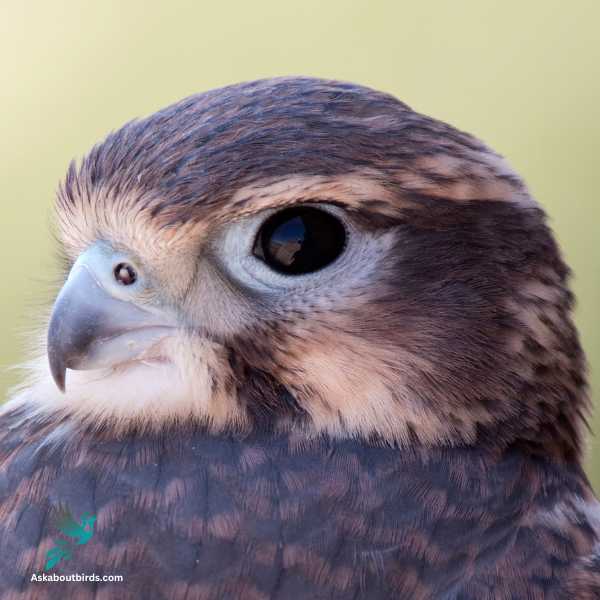
| Falco mexicanus | Measurement |
|---|---|
| Scientific Name | Falco mexicanus |
| Length | 37 to 38 cm (15 inches)/ Female: 45 cm (17.7 inches) |
| Wingspan | 1.1 meters (3.5 feet) |
| Weight | 500 to 635g (1.1 to 1.4 lbs)/Female: 762 to 970g (1.7 to 2.1 lbs) |
The Prairie Falcon is a raptor found in the open landscapes of western North America. Its appearance is often compared to the Peregrine Falcon, though it is generally smaller and has a lighter coloration with a cream to gray-brown body and darker wingtips. The Prairie Falcon is a powerful hunter, preying on small mammals and birds, which it catches in mid-air or on the ground after a high-speed chase. Unlike many other raptors, it often hunts in the heat of the day. The preferred habitats of this bird are deserts, grasslands, and the shrubby areas of the Great Plains, which reflect its name. Their nests are usually scraped out on cliff ledges. Known for their aggressive nature, Prairie Falcons will fiercely defend their nests against intruders.
Similarities
- Prairie Falcons, like hawks, are powerful raptors.
- Both have similar hunting strategies and diets.
Differences
- Prairie Falcons are typically larger and have more pointed wings compared to hawks.
- Unlike hawks, they live primarily in open country.
Black Kite
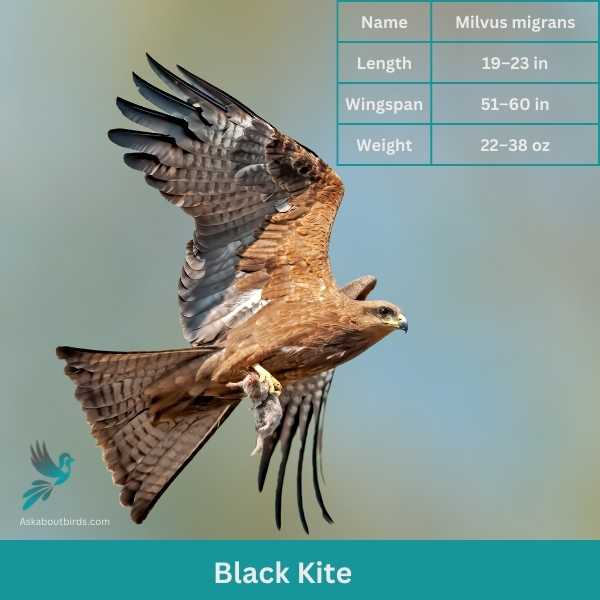
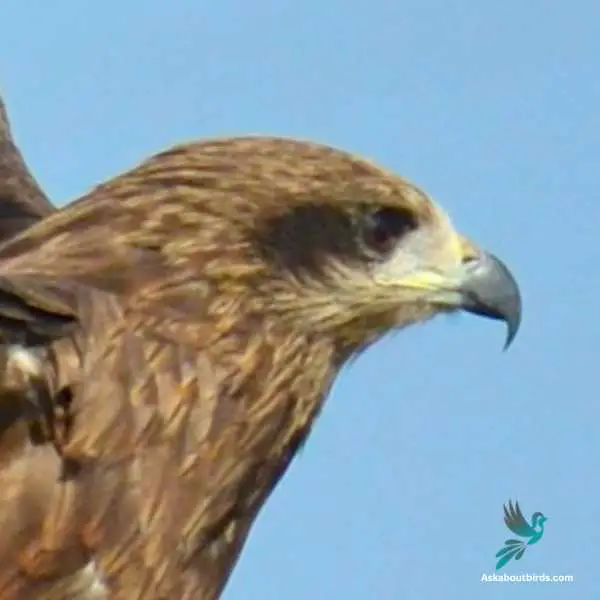
| Feature | Measurement |
|---|---|
| Scientific Name | Milvus migrans |
| Length | 48–58 cm (19–23 in) |
| Wingspan | 130–155 cm (51–60 in) |
| Weight | 560–940 g (22–38 oz) |
The Black Kite is a medium-sized bird of prey that can be found in regions all over the world, from Europe and Asia to Australia and parts of Africa.
Appearance: Black Kites are predominantly brown with a dark rufous coloration on the back of their heads and necks. They have a forked tail, which differentiates them from other types of kites, and their wingtips are black, which give them their name and they have yellow legs. Juveniles have lighter and more mottled plumage than adults.
Diet: These birds are opportunistic hunters and are known to eat a wide variety of foods, from fish and small mammals to carrion and invertebrates. They can also frequently be seen scavenging near human habitations.
Reproduction: Black Kites typically nest in tall trees, where they build large, untidy nests out of sticks and lined with softer materials. Females typically lay 2 to 3 eggs, which are incubated for about 30-32 days.
Similarities
- Black Kites, like hawks, are raptors with strong beaks and talons.
- Both are skilled in flight and hunting.
Differences
- Black Kites are usually smaller and lighter than hawks.
- They have a more forked tail compared to hawks.
Osprey

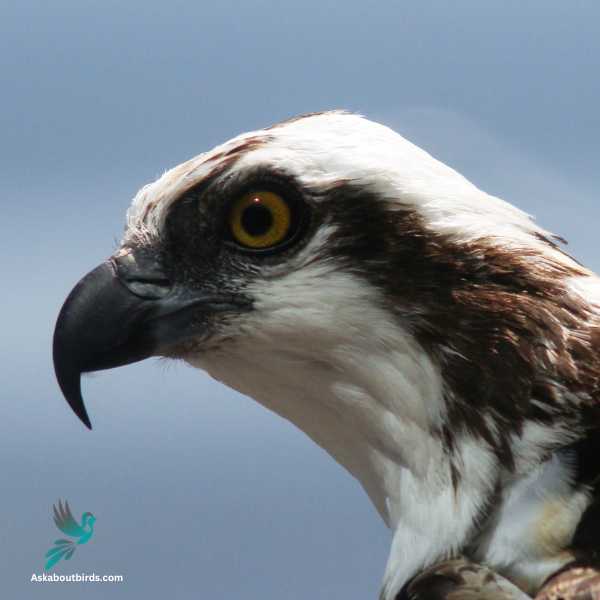
| Feature | Measurement |
|---|---|
| Scientific Name | Pandion haliaetus |
| Length | 50–66 cm (19.5 – 26 in) |
| Wingspan | 127–180 cm (50 – 71 in) |
| Weight | 2 lb 0 oz – 4 lb 10 oz) |
The Osprey, is a unique bird of prey found almost worldwide. It’s distinct for its diet, as it feeds almost exclusively on fish, diving feet-first to catch its prey in bodies of water. This bird is easily identifiable by its dark brown back, contrasting with its white underparts and head, and a distinctive dark eye-stripe that extends to the sides of the neck.
Ospreys are known for their incredible ability to hover in the air while locating fish below, before plunging into the water for the catch. Their nests, made of sticks and lined with softer material, are usually built in open surroundings for easy approach, often on top of trees, poles, or platforms specifically designed to encourage Osprey habitation.
Similarities
- Ospreys share similar raptor traits with hawks, such as sharp talons and beaks.
- Both are strong fliers.
Differences
- Ospreys are specialized fish-eaters, unlike hawks which have a varied diet.
- They have a distinctive white and black coloration, which is not seen in hawks.
Peregrine Falcon

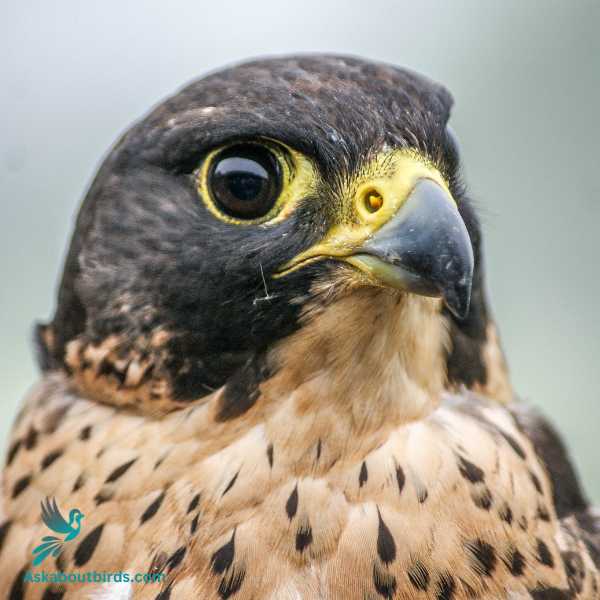
| Feature | Measurement |
|---|---|
| Scientific Name | Falco peregrinus |
| Length | 14.2–19.3 inches |
| Wingspan | 39.4–43.3 inches |
| Weight | 18.7–56.4 ounces |
The Peregrine Falcon, famous for its exceptional speed and hunting prowess, is a well-known bird of prey found across the globe.
Appearance: Peregrine Falcons have a robust build with long, pointed wings and a short tail. Their back and long-pointed wings are slate gray, while the underparts are pale with fine, dark bars. The head is dark, and they have a distinctive “moustache” that contrasts sharply with the white throat.
Diet: Peregrine Falcons primarily feed on other birds, such as pigeons and doves, waterfowl, songbirds, and waders. They are famed for their speed, capable of reaching over 240 miles per hour during high-speed dives to strike prey out of the sky.
Reproduction: Peregrine Falcons often nest on tall structures such as cliff edges or even skyscrapers. The female usually lays three to four eggs, and both parents share incubation duties.
Similarities
- Peregrine Falcons, like hawks, are raptors and skilled hunters.
- Both have strong, hooked beaks and talons for capturing prey.
Differences
- Peregrine Falcons are known for their high-speed stoop (dive), which is not seen in hawks.
- They are often larger and have a more streamlined body shape than hawks.
Merlin

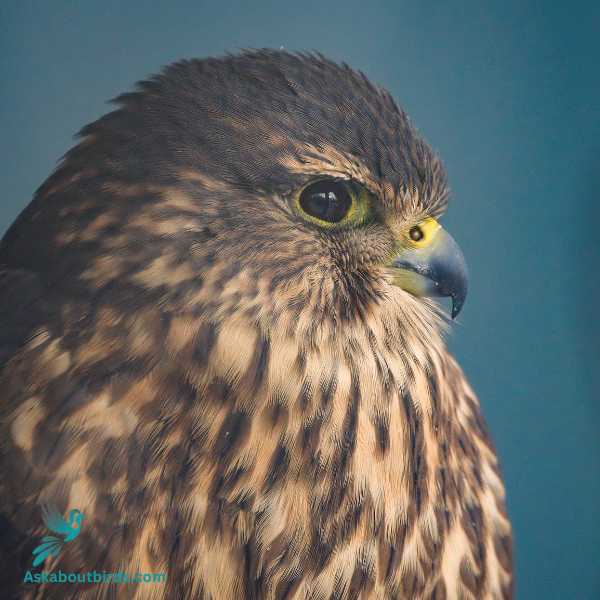
| Feature | Measurement |
|---|---|
| Scientific Name | Falco columbarius |
| Length | 9.4-11.8 inches |
| Wingspan | 20.9-26.8 inches |
| Weight | 5.6-8.5 ounces |
The Merlin, or “pigeon hawk” as it’s often referred to, is a compact and powerful bird of prey that is known for its agility and speed.
Appearance: Merlins have a slender, compact body with a broad-winged and long-tailed silhouette. Their color varies, with males exhibiting a bluish-gray back and a pale, finely barred chest and belly, while females and juveniles are brownish above with a heavily streaked, buff-colored underside.
Diet: These falcons primarily prey on small to medium-sized birds, including sparrows, starlings, and even other small falcons. They are known for their acrobatic flight patterns, and often catch their prey in mid-air.
Reproduction: Merlins typically do not build their own nests, instead, they prefer to take over old crow or hawk nests, or even use a tree hollow. They generally lay 4 to 5 eggs.
Similarities
- Merlins share the raptor characteristics of hawks, such as sharp talons and beaks.
- Like hawks, they are skilled hunters.
Differences
- Merlins are smaller than most hawks.
- They have distinctive dark bands on their tails, which most hawks lack.
Types of Hawk
Hawks, with their powerful beaks and razor-sharp talons, are known for their speed, agility, and precision. They are members of the Accipitridae family and come in various species, each having its unique features and habits. Here are some of the well-known types of hawks found around the world:
- Red-Tailed Hawk: The red tail hawk is one of the most widespread hawks in North America. Known for its brick red tails, the Red-Tailed Hawk soars high in the sky while looking for prey (usually small birds).
- Cooper’s Hawk: Medium-sized raptors, Cooper’s Hawks are famously known for their hunting skills in dense woods. They are often found stalking birds in backyard feeders.
- Sharp-Shinned Hawk: Sharp shinned hawks are the smallest in North America. Their sharp “shins” or lower legs and long tails help them maneuver swiftly through forests when hunting.
- Broad-Winged Hawk: Broad winged hawks are smaller than the Red-Tailed Hawks and are known for their broad wings and migratory habits. They can be spotted soaring in large groups, also known as “kettles,” during migration.
- Rough-Legged Hawk: Named for its feathered legs, the Rough-Legged Hawk breeds in the Arctic and migrates south during winter. It has a unique hover-hunting style.
- Swainson’s Hawk: Known for their long-distance migration to South America, Swainson’s Hawks have a variety of color morphs, but all share a notable “brow” over their eyes.
- Northern Goshawk: This powerful raptor is known for its speed and agility in flight. The Northern Goshawk is the larger cousin to the Sharp-Shinned and Cooper’s Hawks.
- Ferruginous Hawk: As the largest hawk species in North America, Ferruginous Hawks are named for their rust-colored feathers and prefers open grasslands as its habitat.
- Harris’s Hawk: This desert-dwelling hawk is unique for its social behavior. Harris’s Hawks often hunt in groups, a characteristic uncommon in raptors.
- White-Tailed Hawk: Known for its striking white tail and grey body, the White-Tailed Hawk is primarily found in the tropical grasslands of southern Texas and parts of Central and South America.
- Red Shouldered hawk: Red shouldered hawks medium-sized raptor known for its rich, reddish-brown shoulders, banded tail, and distinct kee-rah call, often found in woodlands and wetlands across North America.
FAQS on Birds That Look Like Hawks
What bird is mistaken for a hawk?
Many people often mistake the Northern Harrier or the Osprey for a hawk. The Northern Harrier, with its long tail and wings, has a flight style resembling that of a hawk, while the Osprey’s size and predatory habits can make it seem hawk-like at first glance.
What kind of bird looks like a small hawk?
The American Kestrel, a member of the falcon family, is often mistaken for a small hawk. Its size, coupled with its raptor-like hunting behaviors and the way it holds its wings in flight, contribute to the frequent misidentification.
What is a bird of prey like an eagle or hawk?
Birds of prey, also known as raptors, include species like eagles, hawks, falcons, and owls. They are characterized by keen vision, sharp talons, and curved beaks for hunting and eating prey. A notable example is the Golden Eagle, one of the most powerful raptors in North America.
What is a large hawk like bird?
The Bald Eagle is a large bird of prey often mistaken for a hawk due to its size and predatory nature. However, it’s important to note that while both are raptors, eagles and hawks belong to different genera and have distinctive features and behaviors.

